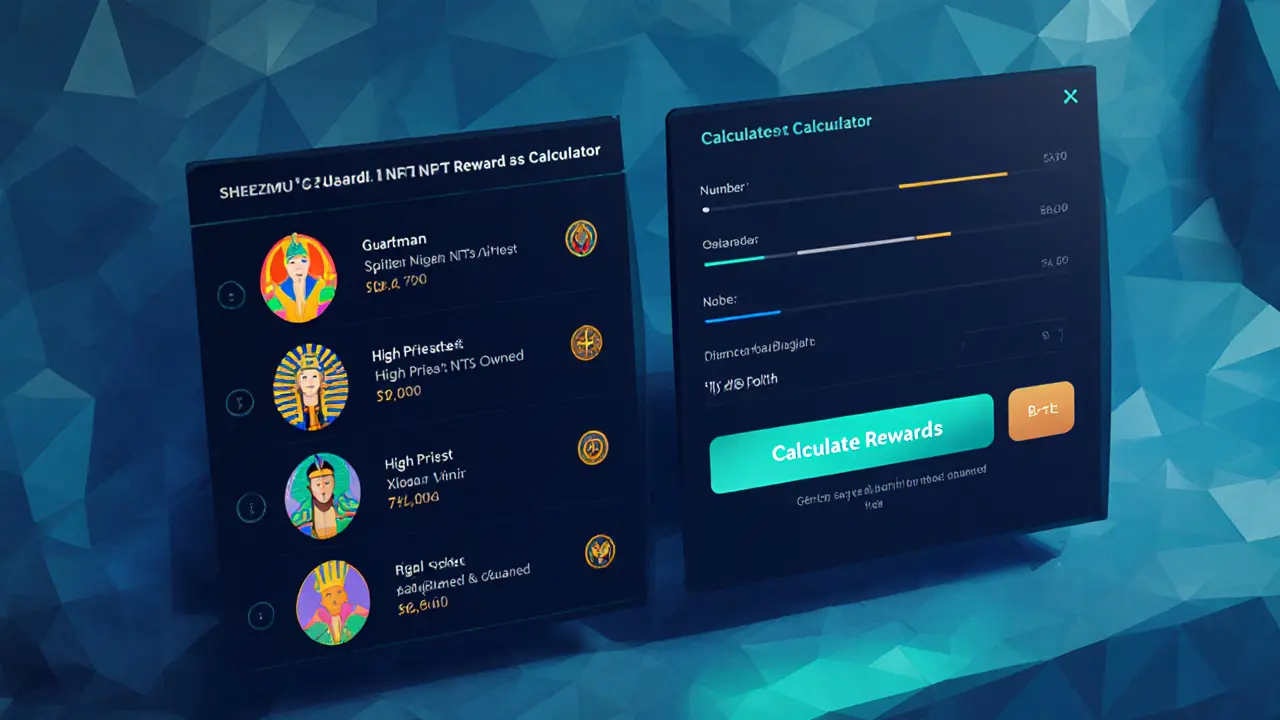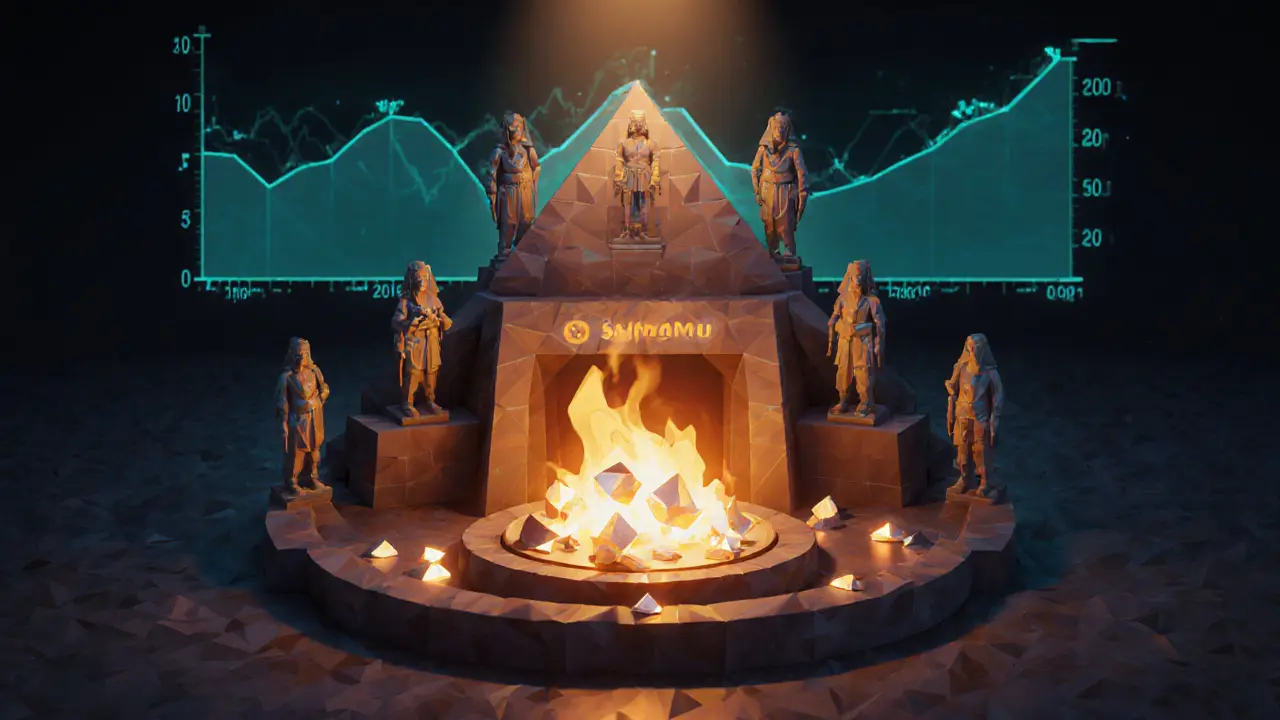Shezmu (SHEZMU) Explained: Hybrid DeFi Lending Token Overview

Shezmu Guardian NFT Reward Calculator
- Craftsman 1 Guardian
- Scribe 5 Guardians
- High Priest 10 Guardians
- Noble 25 Guardians
- Vizier 50 Guardians
- Pharaoh 100 Guardians
- Craftsman 0.025 SHEZMU/day
- Scribe 0.125 SHEZMU/day
- High Priest 0.25 SHEZMU/day
- Noble 0.625 SHEZMU/day
- Vizier 1.25 SHEZMU/day
- Pharaoh 2.5 SHEZMU/day
Enter your Guardian count and number of days to see estimated rewards.
Ever stumbled on a DeFi project that claims to blend crypto lending, NFTs, and elastic token supplies all at once? Shezmu is that kind of experiment, positioning itself as the first hybrid crypto‑lending platform. Below you’ll get a plain‑English walkthrough of what Shezmu actually does, how its unique pieces fit together, and whether it’s worth a glance amid today’s crowded DeFi space.
TL;DR - Quick Takeaways
- Shezmu is a hybrid DeFi protocol that lets you borrow against ERC‑20, ERC‑721 and ERC‑1155 assets.
- The system uses “Guardian” NFTs in six tiers to deliver daily token rewards.
- Token economics rely on burning SHEZMU to mint Guardians, creating a deflationary pressure.
- Current on‑chain metrics show near‑zero TVL and trading volume, indicating early‑stage adoption.
- Price forecasts from 3Commas project modest upside to ~0.15USD by 2035, but analysts flag limited growth potential.
What is Shezmu?
When you first encounter Shezmu a hybrid decentralized finance (DeFi) protocol and cryptocurrency that enables cross‑chain borrowing against multiple token standards, the headline claim is clear: it wants to be a one‑stop shop for crypto lenders who also hold NFTs.
In practice, the platform splits its functionality across four branded zones:
- Oasis - the borrowing interface where users open collateralized debt positions (CDP a smart‑contract vault that locks assets while issuing a loan).
- Agora - a bonding curve where participants lock SHEZMU to receive discount‑priced tokens.
- Bazaar - an NFT marketplace for buying and selling “Guardian” NFTs.
- Nile - a cross‑chain swap hub that moves assets between Ethereum, Binance Smart Chain, and other networks.
The protocol’s native stablecoins - shezUSD a dollar‑pegged token issued within the Shezmu ecosystem, shezETH an ETH‑backed token used for liquidity provisioning and shezBTCEarn a Bitcoin‑linked yield token are minted when users borrow, adding extra layers of utility.
Hybrid Lending Mechanics
Traditional DeFi lenders such as Aave or Compound accept only ERC‑20 tokens as collateral. Shezmu expands that model by allowing ERC‑721 non‑fungible tokens (NFTs) that represent unique assets and ERC‑1155 multi‑token standards that can hold both fungible and non‑fungible items simultaneously. You could lock a collection of digital art, a gaming avatar, and a stablecoin all in one CDP and draw a loan in shezUSD.
The cross‑chain routing component (cross‑chain routing the ability to move assets across different blockchain networks without bridging manually) means the borrowed stablecoins can be swapped to other chains instantly via Nile, reducing gas fees and latency.
Shezmu also employs an elastic supply a dynamic token issuance model that expands or contracts based on demand signals. When users burn SHEZMU to mint Guardians, the supply contracts; when rewards are distributed, the supply can expand to keep incentives in line.
The Guardian System - NFTs Meet Staking
At the heart of the token’s community incentives is the Guardian NFT. Users burn a set amount of SHEZMU to receive a Guardian, which then slots into one of six tiers: Craftsman, Scribe, High Priest, Noble, Vizier, and Pharaoh. Each tier requires more Guardians and pays higher daily rewards in both SHEZMU and USDC.
Here’s a snapshot of the tier structure:
- Craftsman: 1 Guardian → 0.025 SHEZMU/day + USDC.
- Scribe: 5 Guardians → 0.125 SHEZMU/day + USDC.
- High Priest: 10 Guardians → 0.25 SHEZMU/day.
- Noble: 25 Guardians → 0.625 SHEZMU/day.
- Vizier: 50 Guardians → 1.25 SHEZMU/day.
- Pharaoh: 100 Guardians → 2.5 SHEZMU/day + USDC.
Unlike many staking contracts, there’s no lock‑out period. You can sell your Guardians at any time, which addresses a common liquidity gripe among DeFi users.

Token Economics - Burning, Supply, and Price Dynamics
The deflationary loop is simple: to get a Guardian, you must burn permanently destroy a portion of a token’s supply SHEZMU. This reduces circulating supply while increasing the scarcity of each Guardian, theoretically boosting their market value.
Market data as of October2025 is a mixed bag. CoinMarketCap lists SHEZMU at $0.07925USD with zero 24‑hour volume, while 3Commas shows a price of $0.08210USD, $3024‑hour volume, and a market cap around $123k. A third source even mentions $0.14560USD and a $207k market cap. The disparity highlights low liquidity and the need to verify price feeds before trading.
Analyst forecasts from 3Commas paint a cautiously optimistic ceiling: a peak of $0.158USD before 2035, with a floor around $0.079USD. However, the same report flags “poor growth potential,” suggesting the token may struggle to sustain upward momentum without broader adoption.
Security Snapshot
Every DeFi protocol needs a trusted audit. Shezmu’s smart contracts were examined by Hashlock a blockchain security firm that provides formal verification and vulnerability testing. The report’s details aren’t publicly disclosed, but the audit adds a baseline layer of credibility. Users should still treat the platform as experimental, especially given the near‑zero TVL.
How Shezmu Stacks Up - Quick Feature Comparison
| Feature | Shezmu | Aave | Compound |
|---|---|---|---|
| Collateral types | ERC‑20, ERC‑721, ERC‑1155 (multi‑token) | ERC‑20 only | ERC‑20 only |
| Cross‑chain swaps | Built‑in via Nile | Bridge integrations (external) | Bridge integrations (external) |
| Elastic supply | Yes (dynamic token mint/burn) | No | No |
| Guardian NFT staking | Tiered NFT rewards | No | No |
| Liquidity lock‑up | No lock‑out on Guardians | Varies by market | Varies by market |
Step‑by‑Step: Getting Started with Shezmu
- Set up a Web3 wallet (MetaMask, Trust Wallet, etc.) and fund it with ETH or BNB for gas.
- Visit the official Shezmu site and connect your wallet to the Oasis portal.
- Choose the assets you want to lock - you can mix ERC‑20s, NFTs, or ERC‑1155 items.
- Specify the loan amount in shezUSD and confirm the CDP creation.
- If you’re interested in staking, go to the Bazaar, burn the required amount of SHEZMU, and receive a Guardian NFT.
- Collect daily rewards through the Guardian Dashboard. Rewards accrue automatically and can be claimed any time.
- When you’re ready to close, repay the loan plus interest, and unlock your collateral.
That’s the whole loop - borrow, earn, and exit - all without a mandatory lock‑up period.
Pros, Cons, and the Bottom Line
- Pros
- Supports NFT collateral, opening new use‑cases for digital art and gaming assets.
- Cross‑chain routing reduces the need for separate bridge services.
- Guardian NFTs add a gamified staking layer with daily payouts.
- Deflationary burn mechanism could enhance token scarcity over time.
- Cons
- TVL and trading volume are effectively zero - real‑world liquidity is lacking.
- Price data is fragmented, making market entry risky.
- Audit details are opaque; security confidence is moderate at best.
- Growth forecasts are modest; the token may remain niche.
If you’re curious about experimenting with NFT‑backed loans and don’t mind low liquidity, Shezmu offers a sandbox worth checking out. For capital‑preserving investors, the limited adoption signals caution.

Frequently Asked Questions
What assets can I use as collateral on Shezmu?
Shezmu accepts ERC‑20 tokens, ERC‑721 NFTs, and ERC‑1155 multi‑token assets. You can combine them in a single CDP, which is a unique feature compared to most DeFi lenders.
How do Guardian NFTs work?
You burn a specific amount of SHEZMU to mint a Guardian NFT. Depending on how many Guardians you hold, you’re placed in one of six tiers that pay daily rewards in SHEZMU and USDC. There’s no lock‑out, so you can trade your Guardians anytime.
Is Shezmu audited?
The protocol’s contracts were reviewed by Hashlock, a blockchain security firm. While the audit adds a layer of trust, the full report isn’t publicly released, so you should still exercise caution.
What are the current price and market cap of SHEZMU?
Price feeds differ: CoinMarketCap shows $0.079USD with no volume, while 3Commas lists $0.082USD and a market cap near $123k. The discrepancy reflects the token’s low liquidity and the need for multiple data sources.
Can I exit my loan without penalties?
Yes. Repay the borrowed amount plus accrued interest, and your collateral is released instantly. There’s no mandatory lock‑out period for either loans or Guardian NFTs.

Kate Roberge
June 2, 2025 AT 17:43Honestly, the whole hybrid lending thing feels like a buzzword mash‑up meant to lure curious DeFi newbies, but when you dig deeper the utility just isn’t there yet. The NFT‑backed collateral sounds cool on paper, yet the near‑zero TVL tells a different story. And those daily reward rates? They might look tempting until you factor in gas fees and slippage on low‑liquidity markets. I get why some folks are excited, but I’d call it a speculative playground rather than a serious financial tool. Still, if you enjoy watching experimental protocols fumble, Shezmu might give you something to talk about at the next meet‑up.
Jason Brittin
June 2, 2025 AT 17:46Wow, look at Shezmu trying to be the Swiss Army knife of DeFi! 🌟 Mixing ERC‑20, ERC‑721, and ERC‑1155 as collateral is a neat idea, but the real question is: will anyone actually use it? The cross‑chain Nile sounds slick, yet without solid liquidity it’s just a fancy bridge to nowhere. 🤔 Still, kudos for thinking outside the box – if you’re an early adopter who loves tinkering, give it a spin and see if the Guardian NFTs live up to the hype. Just keep your expectations in check and don’t risk more than you can afford to lose! 🚀
VICKIE MALBRUE
June 2, 2025 AT 17:50Shezmu brings fresh ideas to the table and it could be a fun experiment for those who like to try new things without worrying too much about big gains.
april harper
June 2, 2025 AT 17:53One can’t help but marvel at the philosophical undertones of a protocol that treats NFTs like blood‑sucking guardians, each tier promising a higher dose of reward while subtly draining the ether of ambition. Yet, in the grand theatre of DeFi, the curtain rises on an act that feels half‑written, with dialogue that hints at depth but delivers only the surface shimmer of tokenomics. The elastic supply, the burning mechanism – all reminiscent of an alchemist’s quest to transmute cheap metal into gold, only to discover the crucible is empty. Still, perhaps that emptiness is the point: a reflection of our own yearning for meaning in a landscape flooded with hype.
Waynne Kilian
June 2, 2025 AT 17:56i kinda see the point but also feel it could be overcomplicated for most users thts just want simple staking opportunities im not sure if the added layers bring real value or just confuse newcomers
Rajini N
June 2, 2025 AT 18:00Let’s break down the key steps for anyone wanting to experiment safely. First, set up a wallet like MetaMask and fund it with a modest amount of ETH for gas. Next, connect to the Oasis portal and choose a mix of assets – you can lock a single ERC‑20 token, an NFT, or a batch of ERC‑1155 items. When you specify your loan amount in shezUSD, the protocol will calculate the collateralization ratio; keep this comfortably above the minimum to avoid liquidation. If you’re interested in the Guardian NFTs, head over to the Bazaar, burn the required SHEZMU amount, and mint your tier. Rewards accrue daily and can be claimed via the Guardian Dashboard – remember to claim regularly to avoid missing out on compound gains. Finally, when you’re ready to exit, repay the loan plus interest and your collateral will be released instantly. This flow keeps things straightforward while still letting you explore the hybrid features.
Oreoluwa Towoju
June 2, 2025 AT 18:03Nice quick guide. Keep the loan size low to test the waters, and don’t forget to monitor the TVL as it can affect your exit options.
Amie Wilensky
June 2, 2025 AT 18:06When I first saw the Shezmu whitepaper, I couldn’t help but wonder: is this truly a novel approach, or merely a repackaging of existing DeFi concepts? The answer, of course, resides in the details. The protocol’s ambition to fuse NFT collateral with traditional lending is commendable; however, the execution appears half‑baked. For instance, the Guardian NFT rewards are presented as a daily drip, yet the underlying supply dynamics are opaque, leaving participants to speculate on long‑term token value. Moreover, the cross‑chain Nile hub, while theoretically elegant, lacks robust documentation, which could deter users wary of bridging risks. All in all, the project teeters on the edge between innovative and overly complex, demanding a cautious yet curious stance.
Kate Nicholls
June 2, 2025 AT 18:10The reward structure seems appealing at first glance, but when you factor in the need to burn SHEZMU for Guardians, the net gain might be negligible for most holders.
Lindsay Miller
June 2, 2025 AT 18:13That’s a fair point. Burning tokens to receive rewards can feel like a zero‑sum game if the market price doesn’t rise.
Jacob Anderson
June 2, 2025 AT 18:16Looks like another dead token.
Carl Robertson
June 2, 2025 AT 18:20Oh, the tragedy of yet another DeFi chimera that promises the moon while delivering a handful of dust! The Shezmu narrative is drenched in melodramatic flair, painting its hybrid lending model as a revolution, yet the stark reality is a barren landscape of almost non‑existent TVL. One must marvel at the audacity of boasting cross‑chain capabilities when the underlying bridges are barely whispered about in developer forums. The Guardian NFTs, purportedly the crowning jewel, are nothing more than glorified reward tickets that require you to burn precious tokens, creating a self‑defeating loop that erodes value faster than it can be earned. And let us not overlook the tokenomics: an elastic supply that expands with each reward distribution, diluting any semblance of scarcity. The burn‑to‑mint mechanic seems designed to fuel perpetual scarcity, but in practice it simply fuels endless speculation without substance. Moreover, the audit by Hashlock, shrouded in secrecy, adds a veneer of legitimacy that feels more like a marketing ploy than a genuine security endorsement. The price data is a mosaic of contradictions-different platforms reporting divergent values, underscoring the deep liquidity abyss in which this token swims. As an analyst, I can’t help but cringe at the projections that whisper of a modest upside by 2035; such forecasts are built on sand, not steel. While the platform’s ambition to integrate NFTs into borrowing is conceptually intriguing, execution is hampered by a lack of user adoption, fragmented documentation, and an ecosystem that feels half‑finished. In the grand theatre of DeFi, Shezmu is a melodramatic understudy that never gets the spotlight, destined to fade into obscurity once the initial curiosity wanes. Investors would do well to keep their eyes on the exit door, lest they become part of the lingering dust that settles on yet another abandoned experiment.